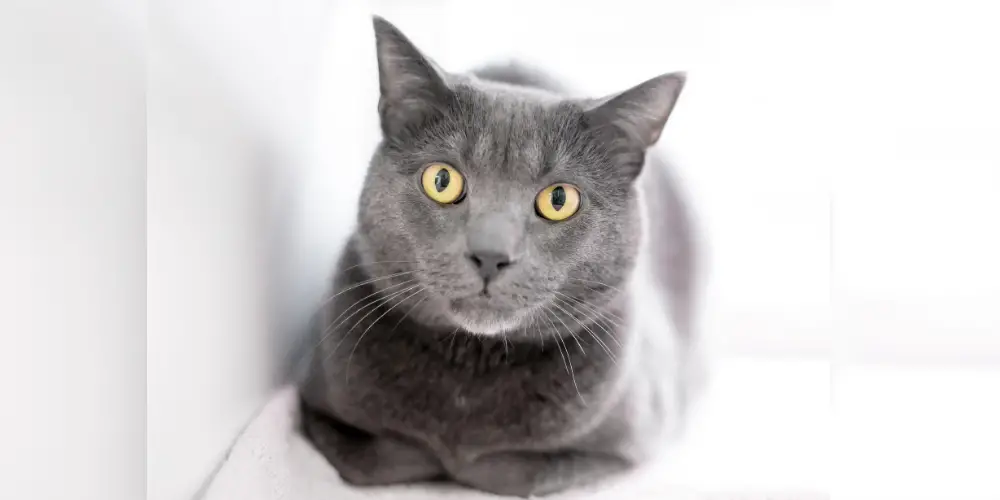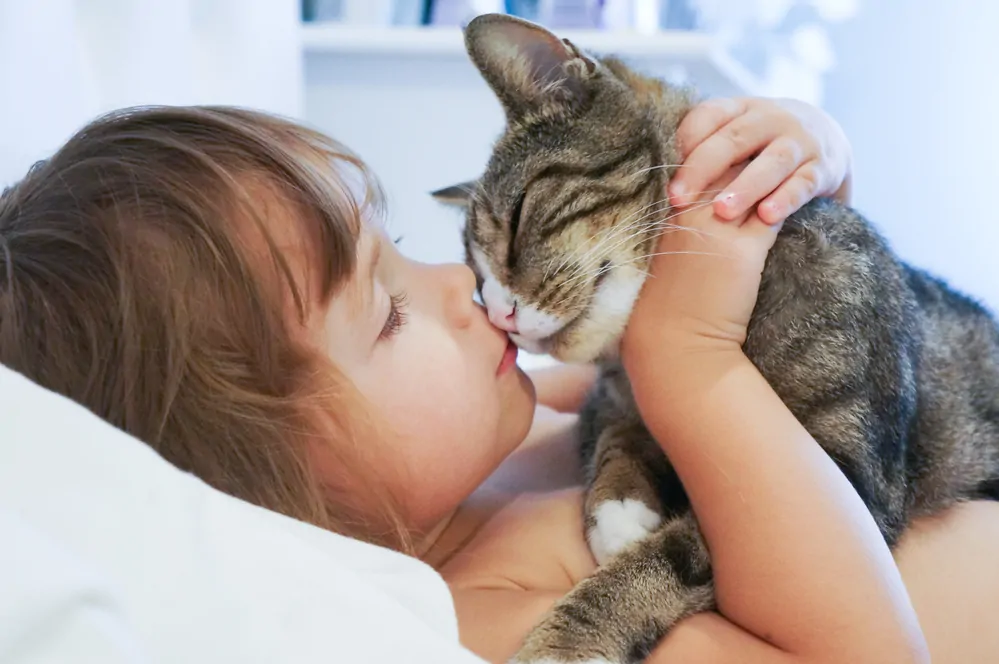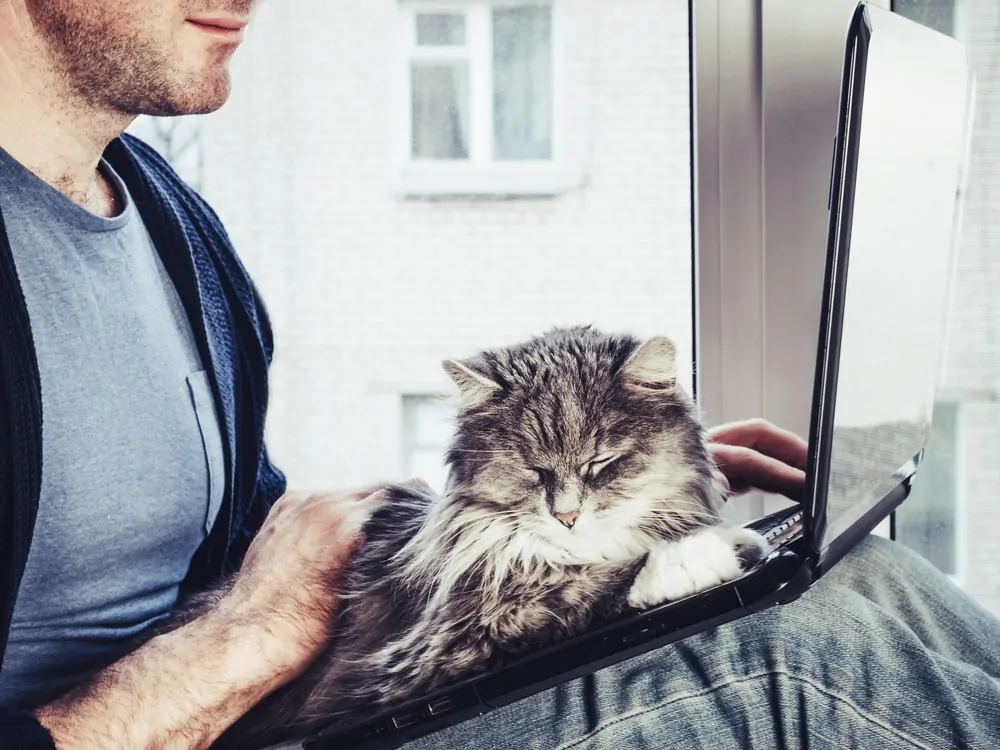Ever caught your cat sitting like a perfectly baked loaf of bread? This charming position is called “cat loafing.” Why do cats loaf?
Cats loaf to relax and conserve energy. Loafing posture minimizes physical exertion, helps regulate body temperature, and signals contentment. It’s a comfortable and efficient resting position for them.
Stick around as we delve into the adorable nuances of this behavior and what it tells us about your feline friend’s well-being.
Key Takeaways
- Cat loafing is a natural behavior that signifies relaxation and contentment in felines.
- The “cat loaf” consists of tucked-in paws, a wrapped tail, and variable ear positions.
- Cat loafing has historical and cultural significance, resembling poses like the Egyptian Sphinx and symbolizing good luck in Japanese folklore.
- Loafing serves various psychological purposes, including comfort, security, and energy conservation.
- Most of the time, cat loafing is a sign of a healthy and content cat.
- Excessive or sudden changes in loafing behavior can indicate underlying health issues, requiring a vet’s consultation.
- Encouraging healthy loafing includes providing cozy spots, soft materials, a peaceful environment, and respectful interaction.
- It’s essential to let cats loaf on their terms; it can’t be forced.
- Understanding cat loafing enriches our appreciation of feline behavior and well-being.
- Cat loafing is a universal language of comfort and emotional state in cats.
The Anatomy of a Cat Loaf
Just like a baker perfects the art of bread-making, a cat seems to have mastered the art of loafing. So, what exactly makes up a “cat loaf”?
Paws Tucked In
The paws are the foundation of the loaf. Tucked neatly beneath the body, they offer comfort and readiness should the cat decide to act.
Tail Wrapped Around the Body
A tucked tail completes the look, often wrapped around to one side or hidden entirely. It adds to the compactness, giving our feline friends a loaf-like appearance.
Ears Perked or Relaxed
Don’t forget the ears! Whether perked up or laid back, a cat’s ears offer subtle clues about their mood while loafing.
Different cats have their unique styles, of course. Some might have a slightly untucked paw or a tail that prefers to roam free. Nonetheless, the basics remain the same: paws in, tail wrapped, and ears doing their own thing.
Historical Overview: From Sphinx to Loaf
Is the cat loaf a recent trend or a practice steeped in history? Turns out, it’s a mix of both, and exploring its historical facets adds depth to the simple act of a cat loafing around.
Resemblance to the Egyptian Sphinx
The loafing position finds its early cousin in the Egyptian Sphinx. While not a perfect match, the Sphinx’s composed, dignified pose resembles the loaf, linking modern felines to ancient history.
Cultural Importance
This pose is more than just an internet meme; it’s a cultural artifact. When we ponder “Why do cats loaf?”, we tap into a rich tapestry of human and feline interactions spanning multiple civilizations.
The Influence of Folklore
Beyond historical art and architecture, the loafing cat appears in folklore across cultures. For instance, Japan’s ‘Maneki-neko’ often assumes a loaf-like pose, symbolizing good luck and prosperity.
The history of the cat loaf offers us more than just cute imagery; it provides a glimpse into the rich tapestry of human-feline interaction over the centuries.
Whether it’s the Sphinx’s majestic pose or a folk tale’s symbol of good luck, the cat loaf has been adding value to human lives for ages.
Psychological Reasons for Cat Loafing
Have you ever wondered what goes on in the mind of a loafing cat? Understanding the psychological aspects can give us a glimpse into a cat’s world, helping us better appreciate this common yet intriguing behavior.
Comfort and Relaxation
The most straightforward reason for cat loafing is comfort. When a cat feels comfortable and safe, it’s more likely to assume this compact, restful posture.
The tucked paws and tail are anatomical features that signify the cat is comfortable and content in its surroundings.
Security and Observation
Though it may look like your cat is napping while loafing, often they are alert to their environment. The loafing position allows a cat to spring into action quickly if needed.
Whether it’s the sudden appearance of a potential prey or a strange noise, a loafing cat is never far from being ready for action.
Cats loaf because it is comfortable and allows them to observe their surroundings
-Dr. Leslie Sinn, a veterinarian at Behavior Solutions in Ashburn, Virginia, and a diplomate with the American College of Veterinary Behaviorists,
Energy Conservation
Cats are natural predators, and predatory behavior requires bursts of high energy. Loafing allows a cat to conserve energy while still being alert.
By reducing the body’s surface area exposed to the surrounding environment, a loafing cat minimizes heat loss, contributing to energy conservation.
Social Signals
What is a loafing cat trying to tell us or other animals? The loafing position often serves as a social signal.
To other cats or pets, a loafing cat might indicate that it feels secure and unthreatened, sending a message of peace and coexistence.
This pose often communicates to humans that the cat feels safe and comfortable, inviting us to engage with them in their calm state.
Understanding the psychological aspects of loafing helps us get closer to our feline friends.
It’s not just a random or cute posture but a multifaceted behavior influenced by various psychological factors.
Health Implications of Cat Loafing
While loafing is generally a sign of a relaxed and content cat, it can sometimes be more than just an adorable pose. Let’s explore when loafing is typical and when it might cause concern.
When Loafing is Normal
Most of the time, a loafing cat is a healthy cat. The pose often indicates that your feline friend is comfortable and content.
Moreover, the ability to loaf for extended periods usually shows that the cat has no underlying health issues affecting its posture or causing it discomfort. So, in most cases, a loafing cat is a healthy sign.
When to be Concerned
However, like any behavior, loafing can become concerning under specific circumstances.
For instance, it might be worth looking into if your cat is loafing excessively and avoiding other positions.
Similarly, if a usually active cat suddenly starts loafing for prolonged periods, it could indicate an underlying health issue such as arthritis or other discomfort.
Consult the Vet
If you notice any significant changes in your cat’s loafing behavior, like an unwillingness to leave the loaf position or visible signs of discomfort, it’s essential to consult a veterinarian.
Timely medical advice can help you rule out any potential health issues and ensure that your cat’s loafing is a sign of comfort and not a symptom of something more serious.
Understanding the health implications of loafing can provide peace of mind and help you ensure your cat is cute and healthy while striking its loaf pose.
Tips for Encouraging Healthy Loafing
So, you’re charmed by the sight of a loafing cat and want to encourage this delightful behavior in your feline friend. Here are some suggestions to create an environment that invites healthy loafing:
Suggest Cozy Spots
Cats are particular about where they loaf. Whether it’s a sunny windowsill or a secluded corner, offering multiple options for your cat can encourage loafing.
Plush cushions, soft blankets, or even specially designed cat beds can make these spots more appealing.
Use Soft Materials
The texture of the surface can make a difference in how comfortably a cat can loaf. Fleece blankets or soft towels can create a cozy environment that practically invites your cat to loaf.
Create a Peaceful Environment
Cats usually loaf when they feel safe and undisturbed. Ensure the loafing area is away from high-traffic regions in your home and free from loud noises.
Using pheromone sprays can also create a calming atmosphere conducive to loafing.
Interact Carefully
Your interaction can either encourage or discourage loafing. A gentle pat or kind words can reinforce the behavior if your cat is loafing.
However, picking up your cat or disturbing them too much might make them less likely to loaf in the future.
Don’t Force It
Remember, you can’t and shouldn’t force your cat to loaf. Cats will loaf when they feel like it.
Our role is to provide them with an environment where they feel comfortable to strike a loaf pose.
Considering these tips, you can encourage healthy loafing behavior in your feline friend, enriching their life and your own.
Conclusion
After journeying through the anatomy, history, psychology, and health implications of cat loafing, it’s clear that this adorable behavior is more than just a cute pose for photos.
Understanding why cats loaf allows us to appreciate the complexities of feline behavior and better cater to their well-being.
Whether it’s a young kitten or a seasoned adult cat, loafing is a universal language that speaks volumes about a cat’s comfort and emotional state.
So, the next time you catch your cat in a loafing position, take a moment to appreciate the beauty and subtlety of this unique posture.
We encourage you to observe your cat’s loafing habits and share your stories or photos with fellow cat enthusiasts. Because, after all, a loafing cat is a story waiting to be told.
RELATED POST: Are Cats Haram?
FAQs: What Cat Owners Often Ask
When it comes to understanding our feline friends, questions often abound. Here are some of the most frequently asked questions about cat loafing that might also be on your mind.
Q1: Can I Train My Cat to Loaf?
Cats naturally loaf; no training is required. They adopt this posture for relaxation. You can create a comfy environment, but cats loaf when they feel like it.
Q2: Is Loafing Exclusive to Domestic Cats?
Loafing is not exclusive to domestic cats. It’s a common resting position in various feline species, including wild cats like lions, tigers, and leopards.
Q3: Does Loafing Indicate My Cat’s Mood?
Cat loafing can indicate your cat’s mood. When cats loaf, they are often content and relaxed. It suggests a calm and comfortable state but doesn’t convey specific emotions.
These questions barely scratch the surface of the fascinating world of cat loafing, but they offer a quick overview for anyone keen on understanding this charming feline behavior better.
References:
- Buis, L. (2021, October 26). Why Do Cats Loaf? – DodoWell – The Dodo. The Dodo. Retrieved from https://www.thedodo.com/dodowell/why-do-cats-loaf
-
Reader’s Digest. (2023, April 17). Why Do Cats Loaf? Retrieved from https://www.rd.com/article/why-do-cats-loaf/
ZumVet Blog. (2023, January 9). Why is My Cat Loafing? [It Could be a Bad Sign]. Retrieved from https://zumvet.com/blog/why-is-my-cat-loafing-it-could-be-a-bad-sign/


